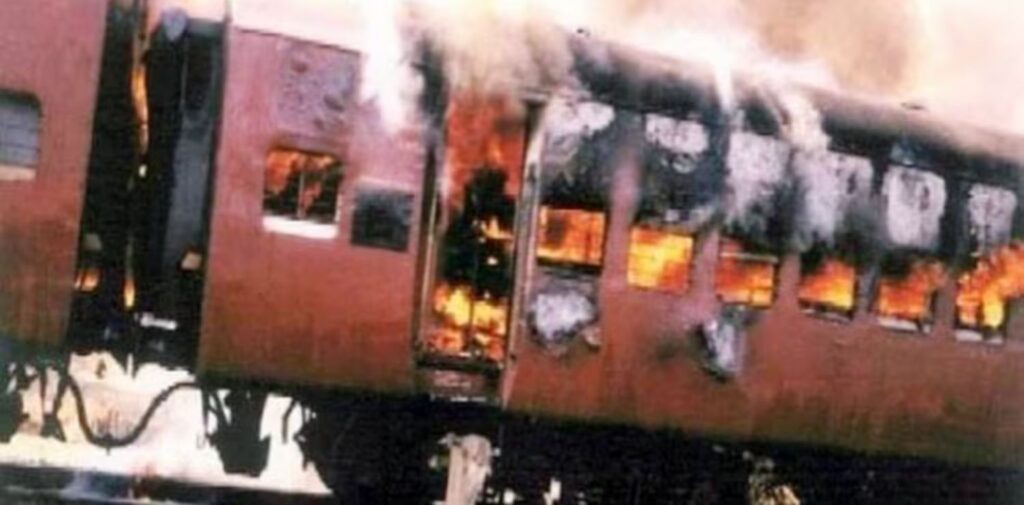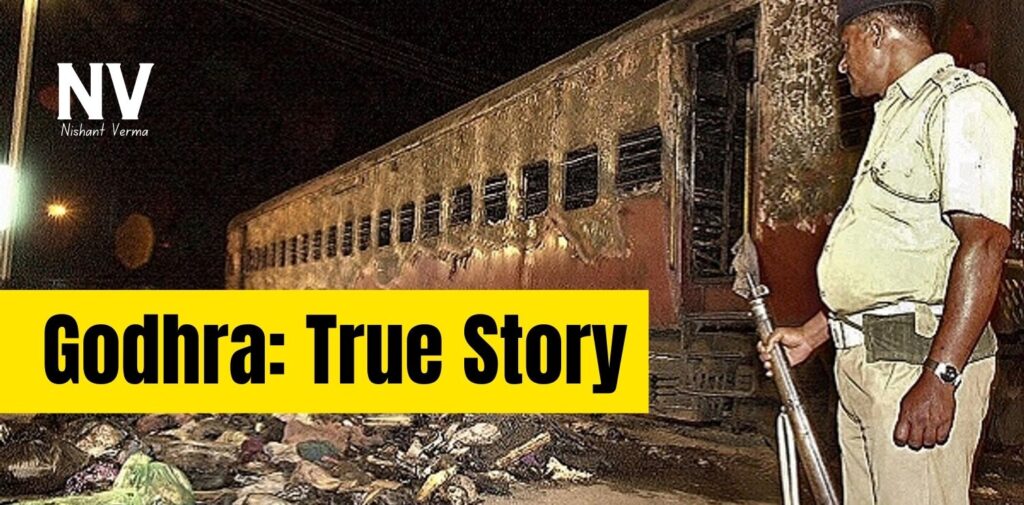The Godhra incident and the riots that followed in 2002 are a highly sensitive and complex topic in India’s history. The incident occurred on February 27, 2002, when a train coach, the S-6 coach of the Sabarmati Express, was set on fire near the Godhra railway station in Gujarat. This tragic event resulted in the death of 59 people, most of whom were karsevaks (Hindu pilgrims) returning from Ayodhya. This incident ignited widespread communal violence across Gujarat, leading to the deaths of hundreds and leaving a long-lasting impact on the state and the country.
The Godhra Train Burning Incident
On the morning of February 27, 2002, the Sabarmati Express, carrying karsevaks from Ayodhya, made a brief stop at Godhra railway station in Gujarat. According to reports, there was a dispute between the passengers and vendors at the station, which escalated rapidly. Soon after the train left the station, a mob reportedly gathered near the train, and within minutes, the S-6 coach was engulfed in flames. The fire led to the death of 59 passengers, including women and children.
The initial reactions were filled with confusion and chaos. There were conflicting narratives about how the fire started. Some reports suggested that it was a planned attack by a Muslim mob, while others argued that the fire could have been accidental or caused by internal factors. However, a Special Investigation Team (SIT) later concluded that the coach was set on fire intentionally by a mob of around 1,000-2,000 people, who used petrol to ignite the flames.

Aftermath: The Riots
The Godhra train burning incident triggered widespread riots across Gujarat, which lasted for several weeks. These riots were marked by intense violence, arson, looting, and killings, leading to the deaths of around 1,000 to 2,000 people, the majority of whom were Muslims. The violence spread rapidly to many parts of the state, and large-scale destruction of property took place.
The scale and intensity of the riots were alarming, and it soon became clear that law and order had broken down in many areas. There were reports of mobs attacking homes, businesses, and places of worship. Many people lost their lives in these targeted attacks, and thousands were displaced, seeking refuge in relief camps.
Political and Social Repercussions
The handling of the riots by the state government, led by then Chief Minister Narendra Modi, came under severe scrutiny. Many alleged that the administration and the police were complicit in the violence or failed to take adequate measures to control the situation. Accusations of bias and inaction were widespread, with some claiming that the state machinery had turned a blind eye to the violence.
This perception led to national and international condemnation, with human rights organizations, the media, and political figures raising concerns over the role of the government and law enforcement agencies. The Indian central government, led by the then-Prime Minister Atal Bihari Vajpayee, faced immense pressure to intervene, and there were calls for the dismissal of the Gujarat government.

Investigations and Legal Proceedings
Several investigations were conducted to determine the causes and perpetrators of the Godhra incident and the subsequent riots. The first of these was carried out by the Gujarat police, followed by a probe by the National Human Rights Commission (NHRC), and later, a Special Investigation Team (SIT) appointed by the Supreme Court of India.
The SIT report, submitted in 2012, concluded that there was no evidence to suggest that the Gujarat government or Chief Minister Narendra Modi had conspired in the violence. The report did, however, find lapses in the handling of the situation by local authorities and police officers, leading to some of them facing legal action.
In the case of the Godhra train burning, the Gujarat High Court upheld the convictions of 31 people accused of conspiracy and murder, while acquitting 63 others who were earlier found guilty. This decision was based on the SIT’s findings, which suggested that the train burning was a planned act of violence.
Controversies and Debates
The Godhra incident and the subsequent riots have been the subject of numerous controversies, debates, and discussions. One of the most contentious points is whether the violence that followed was spontaneous or systematically organized. Critics of the state government allege that the violence was state-sponsored or at least allowed to continue unchecked. Supporters, on the other hand, argue that the administration did its best under challenging circumstances.
The role of the media has also been questioned, with some accusing certain news outlets of spreading misinformation and inflaming tensions. The portrayal of events in the media often differed significantly, with some focusing on the suffering of the Muslim community, while others highlighted the initial tragedy of the Godhra train burning and the plight of the Hindu victims.
Over the years, there have been several attempts to analyze the events through films, books, and documentaries, each offering a different perspective. Some have focused on the political implications of the riots, while others have delved into the human stories of loss, survival, and resilience.

Long-term Impact
The 2002 Gujarat riots left deep scars on the social and political fabric of the state. The violence led to a deepening of communal divides, with many families losing their homes and livelihoods. The affected communities faced challenges in rebuilding their lives, with rehabilitation efforts often falling short.
The riots also had a profound impact on the political landscape of Gujarat and India. Narendra Modi, who was accused by his critics of failing to prevent the violence, went on to win subsequent elections in Gujarat with a strong mandate, solidifying his position as a leader. The events of 2002 have remained a recurring issue in political discourse, with Modi’s critics and opponents frequently raising the topic during elections and other political events.
The Debate on Justice and Reconciliation
The question of justice for the victims of the Godhra incident and the Gujarat riots remains contentious. While many convictions have been secured in both the train burning and riot cases, there are still voices that argue that justice has not been fully served. The slow pace of trials, the acquittal of several accused persons, and the perceived inadequacies in rehabilitation have led to dissatisfaction among the affected communities.
Efforts at reconciliation have been limited, with many victims and their families continuing to live with the trauma of the violence. Organizations and individuals have tried to bridge the communal divide through dialogue and peace-building activities, but the shadow of the riots still lingers.
Conclusion
The Godhra incident and the subsequent riots of 2002 were a tragic chapter in India’s history, marked by loss, suffering, and deep divisions. The events not only took a heavy toll on the people of Gujarat but also had a lasting impact on the nation’s social and political landscape.
Despite the passage of over two decades, the memories of 2002 remain fresh for those who lived through the violence. The incident continues to be a point of contention and debate, with different narratives and interpretations shaping the way it is remembered.
The search for truth, justice, and healing is ongoing, and while significant progress has been made in terms of legal accountability and fact-finding, the emotional and social wounds of 2002 are yet to be fully healed. The Godhra incident and its aftermath serve as a reminder of the need for tolerance, understanding, and the protection of communal harmony in a diverse and multi-ethnic country like India.




